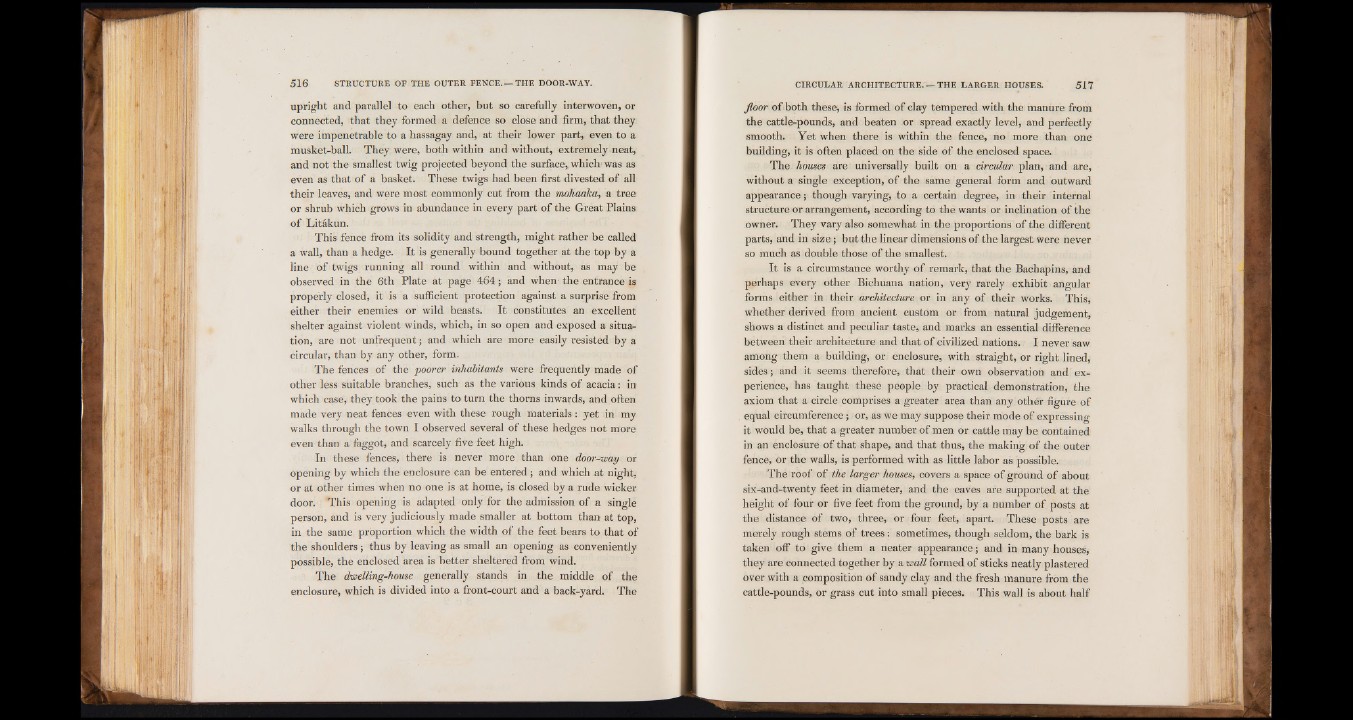
upright and parallel to each other, but so carefully interwoven, or
connected, that they formed a defence so close and firm, that they
were impenetrable to a hassagay and, at their lower part, even to a
musket-ball. They were, both within and without, extremely neat,
and not the smallest twig projected beyond the surface, which-was as
even as that of a basket. These twigs had been first divested of all
their leaves, and were most commonly cut from the mohaaka, a tree
or shrub which grows in abundance in every part of the Great Plains
of Litakun.
This fence from its solidity and strength, might rather be called
a wall, than a hedge. It is generally bound together at the top by a
line of twigs running all round within and without, as may be
observed in the 6th Plate at page 464; and when the entrance is
properly closed, it is a sufficient protection against a surprise from
either their enemies or wild beasts. It constitutes an excellent
shelter against violent winds, which, in so open and exposed a situation,
are not unfrequent; and which are more easily resisted by a
circular, than by any other, form.
The fences of the poorer inhabitants were frequently made of
other less suitable branches, such as the various kinds of acacia: in
which case, they took the pains to turn the thorns inwards, and often
made very neat fences even with these rough materials: yet in my
walks through the town I observed several of these hedges not more
even than a faggot, and scarcely five feet high.
In these fences, there is never more than one door-way or
opening by which the enclosure can be entered; and which at night,
or at other times when no one is at home, is closed by a rude wicker
door. This opening is adapted only for the admission of a single
person, and is very judiciously made smaller at bottom than at top,
in the same proportion which the width of the feet bears to that of
the shoulders; thus by leaving as small an opening as conveniently
possible, the enclosed area is better sheltered from wind.
The dwelling-house generally stands in the middle of the
enclosure, which is divided into a front-court and a back-yard. The
floor of both these, is formed of clay tempered with the manure from
the cattle-pounds, and beaten or spread exactly level, and perfectly
smooth. Yet when there is within the fence, no more than one
building, it is often placed on the side of the enclosed space.
The houses are universally built on a circular plan, and are,
without a single exception, of the same general form and outward
appearance; though varying, to a certain degree, in their internal
structure or arrangement, according to the wants or inclination of the
owner. They vary also somewhat in the proportions of the different
parts, and in size; but the linear dimensions of the largest were never
so much as double those of the smallest.
It is a circumstance worthy o f remark, that the Bachapins, and
perhaps every other Bichuana nation, very rarely exhibit angular
forms either in their architecture or in any of their works. This,
whether derived from ancient custom or from natural judgement,
shows a distinct and peculiar taste, and marks an essential difference
between their architecture and that of civilized nations. I never saw
among them a building, or enclosure, with straight, or right lined,
sides; and it seems therefore, that their own observation and experience,
has taught these people by practical demonstration, the
axiom that a circle comprises a greater area than any other figure of
equal circumference; or, as we may suppose their mode of expressing
it would be, that a greater number of men or cattle may be contained
in an enclosure of that shape, and that thus, the making of the outer
fence, or the walls, is performed with as little labor as possible.
The roof of the larger houses, covers a space of ground of about
six-and-twenty feet in diameter, and the eaves are supported at the
height of four or five feet from the ground, by a number of posts at
the distance of two, three, or four feet, apart. These posts are
merely rough stems of trees: sometimes, though seldom, the bark is
taken off to give them a neater appearance; and in many houses,
they are connected together by a wall formed of sticks neatly plastered
over with a composition of sandy clay and the fresh manure from the
cattle-pounds, or grass cut into small pieces. This wall is about half